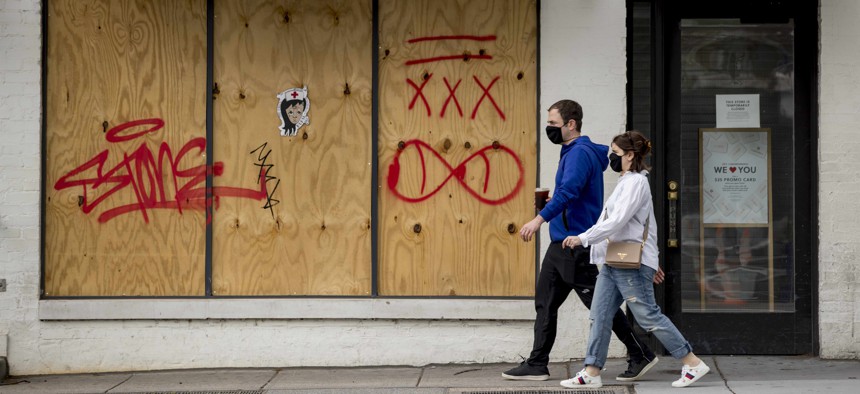A Budget Shortfall Estimate for States Grows Even Worse

People in masks to protect against coronavirus, walk past a boarded up storefront along 14th Street in Northwest Washington, Wednesday, April 29, 2020. AP Photo/Andrew Harnik

Connecting state and local government leaders
Updated figures from a think-tank found that the hit to state finances will be worse than the Great Recession.
State governments could face budget shortfalls over three fiscal years totaling around $650 billion as the coronavirus outbreak batters the nation’s economy, according to new estimates from a liberal-leaning think tank.
The Center on Budget and Policy Priorities published the estimate on Wednesday. It is even more downbeat than a roughly $500 billion shortfall figure the group released earlier this month. If the latest estimate is accurate, it means states are in line to take a hit to their budgets that could be much deeper than the one dealt by the Great Recession.
State budget shortfalls during the three-year 2009 to 2011 timeframe, after the last recession struck, totaled $510 billion after adjusting for inflation into present day dollars, according to CBPP.
Researchers with the center based their estimates on economic projections from both the nonpartisan Congressional Budget Office and Goldman Sachs. The estimates are for states only and do not capture the financial troubles that local governments, territories and tribes could face.
The figures show that state budgets will experience their largest shortfall—$350 billion—in the upcoming 2021 fiscal year, which begins in July in most states. That amount is equal to about 17% of the $2 trillion in actual total state spending that the National Association of State Budget Officers documented for fiscal year 2018 in a report released late last year.
In the current 2020 budget cycle, the Center on Budget and Policy Priorities predicts the state shortfall figure will be $110 billion and it says in the 2022 fiscal year states could run short $190 billion.
Liz McNichol, a senior fellow at the center, explained in an email that the shortfalls are an estimate of how much state revenues will fall and state spending—mainly on Medicaid—will increase as a result of the pandemic. But the estimates, she added, do not include the direct costs that states are taking on to address the health crisis.
More on the methods that the researchers used to come up with their figures is outlined in a report published earlier this month.
The estimates come amid a growing debate over how much further the federal government should go to help states and local governments deal with the costs and tax revenue losses that the highly contagious virus, and measures to control it, are driving.
Congress allotted around $200 billion in aid for states, localities, schools and higher education institutions, in the CARES Act, which President Trump signed into law last month. That total sum includes $139 billion in a special Coronavirus Relief Fund to help states and larger-sized local governments with covering costs tied to the pandemic.
But states have little flexibility to use large portions of the CARES Act money to offset revenue losses they are facing because of the economic crash the virus triggered.
During the long economic recovery after the last recession, many states built up their “rainy day” fund reserves. CBPP points out, however, that the funds collectively held only about $75 billion in savings at the end of the last fiscal year, and balances vary widely between states.
The Center on Budget and Policy Priorities says that one way the federal government could provide states with greater budget relief is by increasing the federal share of Medicaid costs, known as the “federal medical assistance percentage”—and doing so beyond an FMAP increase included in coronavirus relief legislation that preceded the CARES Act.
But CBPP also says that this on its own will likely not be enough and recommends that Congress take additional steps, like expanding the CARES Act relief fund program for states and local governments, while also loosening restrictions on how this funding can be used.
House Speaker Nancy Pelosi on Tuesday indicated that Democrats were supportive of another $500 billion in aid for states, along with additional relief funding for local governments. She also voiced support for increasing federal funding for Medicaid by boosting the FMAP. Republicans have so far been cooler about the idea of a massive new infusion of state and local aid.
Bill Lucia is a Senior Reporter for Route Fifty and is based in Olympia, Washington.

NEXT STORY: Looking for Extra Cash? Check Your State’s Unclaimed Property Database





